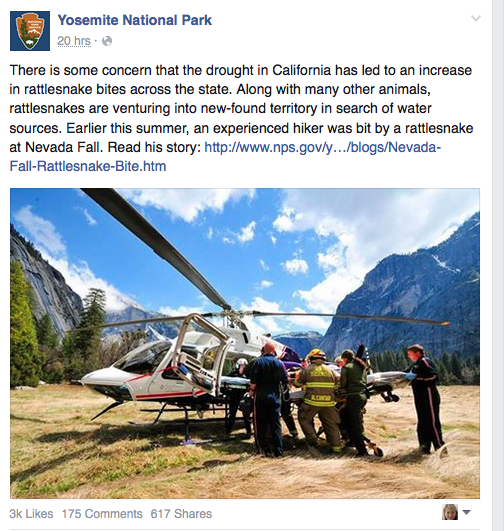There is some concern that the drought in California has led to an increase in rattlesnake bites across the state. Along with many  other animals, rattlesnakes are venturing into new-found territory in search of water sources. Earlier this summer, an experienced hiker was bit by a rattlesnake at Nevada Fall. The story was posted today on Facebook with a link to the Yosemite National Park website. Below is an excerpt:
other animals, rattlesnakes are venturing into new-found territory in search of water sources. Earlier this summer, an experienced hiker was bit by a rattlesnake at Nevada Fall. The story was posted today on Facebook with a link to the Yosemite National Park website. Below is an excerpt:
On June 29, 2015, sometime around 4 pm, a 49-year-old day hiker at the top of Nevada Fall experienced what many people would consider their worst nightmare: being bitten, and envenomated, by a rattlesnake. He was an experienced hiker and had come across rattlesnakes in the wild before.
The top of Nevada Fall was the objective for the subject and his family. Upon reaching the footbridge at the top of the fall, they decided to do what many hikers feel the need to do after walking in the afternoon heat: take off their shoes and cool their feet at a safe spot in the river. As the subject made his way back onto the granite shoreline, he stepped down into a shallow recess between several rocks and was immediately bitten on the right foot. Moments later, another member of the subject’s family dialed 911 and reported the incident, at which time Yosemite Search and Rescue began to mobilize their response.
A rescue team began hiking to the patient's location as park helicopter 551 mobilized. Approximately one hour after being bitten, 551 airlifted the subject from the top of Nevada Fall and flown to the valley floor, where medical care was waiting. The clinic staff administered antivenom medication to the subject, stabilized him, and readied him for transport to a regional hospital via a medical helicopter.
Many people see rattlesnakes while hiking in Yosemite. Snake bites are rare here, but it is important to know that they do occur and that the resulting injuries can be serious: this subject spent several days in the hospital recovering from his bite. It is understandable that the patient was barefoot while wading, but for the rest of the hike, a pair of snake boots or other sturdy shoes can protect against many snakebites. Snake gaiters offer snake bite protection from approximately your knee down to your ankle and should be worn with sturdy boots. An important lesson to learn from this incident is to always be aware of where you place your hands and feet—in addition to snakes, crevices can hide scorpions, spiders, and yellow jacket nests. This hiker didn't do anything wrong. In this case it just happened to be that a viper proved to be the most dangerous part of the trip— not the obvious hazards of the quickly flowing river, the granite cliffs, or the midday heat.
If you are bitten, keep in mind that the most effective treatment for snakebite is to seek medical care at a hospital or emergency room as quickly as possible. Gone are the days when snakebite first aid involved cutting into the bite and sucking the venom out of the body. Don't try it! It doesn't work!
Finally, treat all wildlife with respect and give them the space they need to stay wild. Never approach wildlife to feed, pet, or photograph them. No matter how docile the animal or reptile may appear, it is wild and could spook easily.